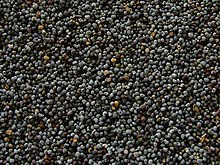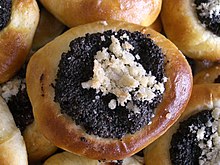Poppy seed


Poppy seed is an
History

The poppy seed is mentioned in ancient medical text from many civilizations. For instance, the Egyptian papyrus scroll named Ebers Papyrus, written c. 1550 BC, lists poppy seed as a sedative.[1] The Minoan civilization (approximately 2700 to 1450 BC), a Bronze Age civilization which arose on the island of Crete, cultivated poppies for their seed, and used a milk, opium and honey mixture to calm crying babies. The Sumerians are another civilization that are known to have grown poppy seeds.[2]
Description
Poppy seeds are less than a millimeter in length, kidney-shaped, and have a pitted surface.[3] It takes about 3,300 poppy seeds to make up a gram, and between 1 and 2 million seeds to make up a pound.[2] The primary flavor compound is 2-pentylfuran.[4]
The seeds are cultivated for the flowers they produce. Annual and biennial poppies are used to cultivate from seed as they are not difficult to
Production
| Poppy seed production (tonnes) | ||
|---|---|---|
| Country | 2018 | 2014–2018 average |
| 26,991 | 21,479 | |
| 13,666 | 22,739 | |
| 12,360 | 11,812 | |
| 4,514 | 5,467 | |
| 3,800 | 6,047 | |
| Source: FAOSTAT of the United Nations[6]
| ||
In 2018, world production of poppy seeds was 76,240 tonnes, led by Turkey with 35% of the world total, followed by the Czech Republic and Spain as other major producers (table).[6]
The poppy seeds harvest can be a
but a large amount is needed, around 300–400 g depending on the levels of opiates.Since poppy seeds are relatively expensive, they are sometimes mixed with the seeds of Amaranthus paniculatus, which closely resemble poppy seeds.[8]
Nutrition
 | |
| Nutritional value per 100 g (3.5 oz) | |
|---|---|
| Energy | 2,196 kJ (525 kcal) |
28.13 g | |
| Sugars | 2.99 g |
| Dietary fiber | 19.5 g |
41.56 g | |
| Saturated | 4.517 g |
| Monounsaturated | 5.982 g |
| Polyunsaturated | 28.569 g |
21.22 g | |
Niacin (B3) | 6% 0.896 mg |
| Pantothenic acid (B5) | 0% 0 mg |
| Vitamin B6 | 15% 0.247 mg |
| Folate (B9) | 21% 82 μg |
| Choline | 9% 52.1 mg |
| Vitamin C | 1% 1 mg |
| Vitamin E | 12% 1.77 mg |
| Vitamin K | 0% 0.0 μg |
Copper | 0% 0 mg |
| Iron | 54% 9.76 mg |
| Magnesium | 83% 347 mg |
| Manganese | 99% 2.285 mg |
| Phosphorus | 70% 870 mg |
| Potassium | 24% 719 mg |
| Selenium | 0% 0 μg |
| Sodium | 1% 26 mg |
| Zinc | 64% 7.0 mg |
| Other constituents | Quantity |
| Water | 5.95 g |
| †Percentages estimated using US recommendations for adults,[9] except for potassium, which is estimated based on expert recommendation from the National Academies.[10] | |
In a 100 gram amount, poppy seeds provide 525
(table).Food products
Intact seeds
Whole poppy seeds are widely used as a spice and decoration in and on top of many baked goods and pastries. In
The color of poppy seeds is important in some uses. According to
Paste

Poppy seeds can be ground using a generic tool such as a
The
Poppy seed paste is available commercially, in cans. Poppy seeds are very high in oil, so commercial pastes normally contain sugar, water, and an emulsifier such as
In the United States, commercial pastes are marketed under brand names including Solo and American Almond. Per 30 gram serving, the American Almond poppy seed paste has 120 calories, 4.5 grams fat, and 2 grams protein.
Oil
Poppy seeds are pressed to form poppyseed oil, a valuable commercial oil that has multiple culinary and industrial uses.
Other uses
Poppy seeds are often used as bird seed, in which case they are usually called maw seeds.[12]
Use by cuisine
Poppy seeds are used around the world in various cuisines.
European cuisine

Across Europe,
Blue poppy seeds are widely used in Austrian, Croatian, Czech, Danish, German, Hungarian, Lithuanian, Polish, Romanian, Russian, Serbian, Slovak, Slovenian, Turkish and Ukrainian cuisines.
The states of former Yugoslavia (notably North Macedonia and Serbia, but also Croatia and Bosnia) have a long tradition of preparing poppy seed pastry (štrudla, baklava, pajgle) and dishes (pasta with poppy seeds). In Slovenia blue poppy seeds are used in traditional dishes such as prekmurska gibanica and makova potica.
In Poland, Hungary, Lithuania and Eastern Slovakia, a traditional dessert is prepared for the Christmas Eve dinner from poppy seeds. They are ground and mixed with water or milk; round yeast biscuits (kūčiukai in Lithuanian; opekance or bobalky in Slovak) are soaked in the resulting poppy seed 'milk' (poppy milk) and served cold.
In Central Europe, poppy strudel is very popular, especially during Christmas. In Germany, Poland and countries belonging to the former Austro-Hungarian Empire, poppy seed pastries called Mohnkuchen are often eaten around Christmas time.[13] Recipes for Mohnstriezel use poppy seed soaked in water for two hours[14] or boiled in milk. A recipe for Ukrainian poppyseed cake recommends preparing the seeds by immersing in boiling water, straining and soaking in milk overnight.[15]
Jewish cuisine
In Eastern European
Indian cuisine


In
Poppy seeds, along with
and khus khus milk.Pakistani cuisine
Poppy seeds locally called "khashkhash" are an essential ingredient in the preparation of a dish that consists of minced meat balls locally called "Kofta".
Health effects
Allergy (type 1 hypersensitivity) to poppy seeds is rare, but has been reported[17][18] and can cause anaphylaxis.[18]
False positive drug tests
Although the drug
Legal status
The sale of poppy seeds from Papaver somniferum is banned in Singapore because of the morphine content. Poppy seeds are also prohibited in Taiwan, primarily because of the risk that viable seeds will be sold and used to grow opium poppies.[21]
China prohibits spice mixes made from poppy seed and poppy seed pods because of the traces of opiates in them, and has since at least 2005.[22][23]
Despite its present use in Arab cuisine as a bread spice, poppy seeds are also banned in Saudi Arabia for various religious[citation needed] and drug control reasons.[24] In one extreme case in the United Arab Emirates, poppy seeds found on a traveler's clothes led to imprisonment.[25][26] Concerns were raised in Malaysia by MP Datuk Mohd Said Yusof who claimed in 2005 that mamak restaurants used poppy seeds in their cooking to get customers addicted to it.[27]
It is illegal to grow opium-bearing cultivars of Papaver genus in Russia, although selling poppy seeds is not restricted in most regions.[citation needed]
International travelers
As poppy seeds cause false positive results in drug tests, it is advised in airports in India not to carry such items to other countries, where this can result in punishments based on false positive results. Travelers to the United Arab Emirates are especially prone to difficulties and severe punishments.[28][29]
In Singapore, poppy seeds are classified as "prohibited goods" by the Central Narcotics Bureau (CNB).[30]
Gallery
-
Dried poppy seed pods next to glass jars of blue, gray, and white poppy seeds used for pastries in Germany
-
Macro photograph of poppy seeds
-
White poppy seeds, close up
-
Czech blue poppy seeds (as food)
-
A cut green seed pod with fresh latex
-
Electron micrograph of a poppy seed
-
Energy-dispersive X-ray analysis showing high content of calcium and other mineral elements in the seed
See also
References
- ISBN 978-0-8493-2842-8.
- ^ a b
McGee, Harold (2004). On Food and Cooking: The Science and Lore of the Kitchen. Simon and Schuster. p. 513. ISBN 978-0-684-80001-1.
- United States Government Printing Office. 1896. p. 203.
- ISBN 0-8493-9848-7
- ^ "Poppy, chamomile and larkspur seeds are planted outside in January." Day, Molly (2009-01-14). "Gardening: Work to get seeds started in January". Muskogee Phoenix. Archived from the original on 2012-09-04. Retrieved 2009-01-24.
- ^ a b "Poppy seed production in 2018, Crops/Regions/World list/Production Quantity (pick lists)". UN Food and Agriculture Organization, Corporate Statistical Database (FAOSTAT). 2019. Retrieved 30 August 2020.
- ^ "Poppy law" on Erowid.org
- ISBN 978-1-85573-299-5.
- ^ United States Food and Drug Administration (2024). "Daily Value on the Nutrition and Supplement Facts Labels". Retrieved 2024-03-28.
- )
- ISBN 978-0-7432-4626-2.
- ^ Ward, Artemas (1911). The Grocer's Encyclopedia (1st ed.). New York: James Kemster Printing Co. pp. 492–495. Retrieved July 5, 2014.
- ISBN 978-0-9665062-0-4.
- ^ Mohnstriezel-Poppy-Seed-Cake. Recipezaar.com. Retrieved on 2015-04-24.
- ^ Walter, Joyce (2009-01-10). "Ukrainian community in midst of celebrations". The Moose Jaw Times Herald (Saskatchewan). Archived from the original on 2009-03-02. Retrieved 2009-01-24.
- ^ "How British greed spurred the creation of one of Bengal's most loved dishes". The Indian Express. 2016-03-31. Retrieved 2023-09-01.
- PMID 16948357.
- ^ PMID 18564637.
- ^ a b c "Can athletes eat poppy seeds without testing positive?". United States Anti-Doping Agency. 2014-02-10.
- ^ O'Connor, Anahad (2005-01-11). "The Claim: Eating Poppy Seeds Can Make You Fail a Drug Test". The New York Times.
- ^ "Court convicts bagel shop owner over poppy seeds - Taipei Times". 4 May 2001. Retrieved 20 April 2017.
- ^ "Controls over poppy seed strengthened". Asia Times. October 18, 2005. Archived from the original on March 16, 2006. Retrieved April 20, 2017.
{{cite web}}: CS1 maint: unfit URL (link) - ^ "In China, poppy seedpod is a spice too hot to handle". 21 October 2013. Retrieved 20 April 2017 – via LA Times.
- ^ Ignorance Is No Excuse for Breaking Law. Arabnews.com (2006-01-10). Retrieved on 2015-04-24.
- ^ Tourists warned of UAE drug laws. BBC News (2008-02-08). Retrieved on 2015-04-24.
- Fair Trials International. Archived from the originalon 2014-10-18.
- ^ "Health Ministry: Kas-kas won't be banned in Malaysia yet". The Rakyat Post. 14 April 2016. Archived from the original on 17 June 2016. Retrieved 2 May 2016.
- ^ Travel Warning – Khas Khas (Poppy Seed) Imprisonment in UAE Archived 2017-06-19 at the Wayback Machine. Hoax-slayer.com. Retrieved on 2015-04-24.
- ^ "Indian in UAE denies using poppy seeds as drugs". Yahoo News India. IANS. July 10, 2014. Archived from the original on March 5, 2016. Retrieved July 17, 2014.
- ^ "I would like to know if I am allowed to bring poppy seeds into Singapore for my baking business". Retrieved 31 August 2015.
Further reading
- Jenő Bernáth. Poppy: The Genus Papaver. CRC Press, 1998. ISBN 978-90-5702-271-5.
 Media related to Poppy seeds at Wikimedia Commons
Media related to Poppy seeds at Wikimedia Commons







